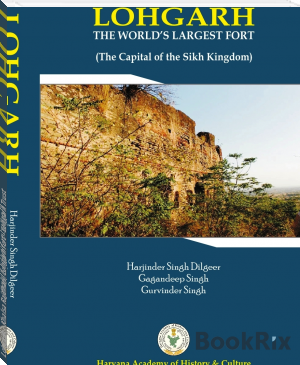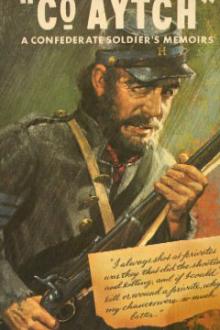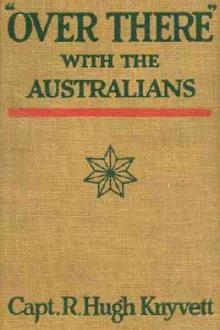Lohgarh - Khalsa Rajdhani, Lohgarh fort - Lohgarh Trust by S. Daljeet Singh Bajwa (books that read to you .TXT) 📕

- Author: S. Daljeet Singh Bajwa
Book online «Lohgarh - Khalsa Rajdhani, Lohgarh fort - Lohgarh Trust by S. Daljeet Singh Bajwa (books that read to you .TXT) 📕». Author S. Daljeet Singh Bajwa
John Sermon and Edwards, Stephen, the Delhi representatives of the British Governor at Fort William (Calcutta), in a letter written on March 10, 1716, have given an eyewitness account of these executions: “The great Rebel Guru who has been for these past 20 years so troublesome to the Subaship of Lahore, is at length taken with all his family and attendance by Abd-Us-Samad Cawn, the Suba of that province. Some days ago, they entered the city laden with fetters, his whole attendance, which were left alive, being about seven hundred and eighty, all severally mounted on camels which were sent out of the city for that purpose, besides about two thousand head struck upon poles, being those who died by the sword in battle. He was carried into the presence of the King, and from thence to a close prison. He, at present, has his life prolonged with most of his mutsuddys, in hope to get an account of his treasure in the several parts of his kingdom and of those who assisted him, when afterwards he will be executed; for the rest there are 100 each day beheaded. It is not a little remarkable with what patience they undergo their fate, and to the last it has not been found that one apostatized from his new formed religion”. Sarup Das Bhalla
(in Mahima Parkash) writes that Kahan Singh Trehan (a descendant of Guru Amar Das) too was one of the Sikh prisoners. According to Sarup Das, Kahan Singh was swapped with another Sikh so that he (Kahan Singh), being the descendant of a Guru, might be saved from execution. This is just another concoction. First, it was impossible for a Sikh to reach there and get another one released. Secondly, it is un-Sikh like act to get a Sikh killed in order to save another. This is unhistorical too. Even Guru Gobind Singh did not try to save his sons in the battle of Chamkaur. He sent his sons to fight and die (on the 7th of December 1705); instead of his sons, he saved some Sikhs who escaped from the Fortress of Chamkaur along with him on the night of 7th and 8th of December 1705.
More than seven hundred Sikh prisoners were executed by the 12th of March 1716. Their dead bodies were cut into pieces and these pieces were hung upside down from trees in different parts of the city of Shahjahanabad (Delhi). The flesh from these body parts was eaten by the vultures, but the skeletons and bones remained hanging. Wanton Muslim children used to hit these bones with bricks and stones in order to express their anger against the Sikhs.34
After the execution of these more than seven hundred Sikhs, Farukhsiyar handed over Banda Singh and other 18 Sikhs35 to Tikka Ram, to imprison them in Tripolia Fort. Banda Singh’s wife Sushil Kaur (of Chamba) and his son Ajay Singh were sent into the custody of Darbar Khan Nazir.
Khafi Khan claims that some rich people offered a big amount of money to Mohammed Amin Khan to release Banda Singh but he refused to have even a dialogue on this issue. This too seems to be another concoction because at that time none could have dared to present oneself as an agent or even as a sympathizer of the Sikhs.
Banda Singh and his companions were tortured for the next three months; they too were offered life if they accepted to embrace Islam but none of them chose to do so. Finally, on the 9th of June, Farukhsiyar ordered the execution of Banda Singh and his companions. The Emperor ordered Ibrahim-Ud-Din (Mir Aatish) and Sarbrah Khan (Kotwal) that Banda Singh should be first tortured and then killed.36 The order included
cutting of his tongue, pulling out his eyes, pulling skin from his flesh and tearing flesh from his bones; and also killing his son before his eye. According to Khafi Khan, the Emperor had ordered that Banda Singh should be forced to kill his own son with his own hands.
The execution was to be carried near the tomb of Khwaja Qutub- Ud-Din (near Qutub Minar) at Mehrauli. The order of the Emperor was translated into action immediately and Banda Singh was at once taken to the site of execution.
At Mehrauli, Banda Singh was taken around the tomb of Khwaja Kutub-Ud-Din and then brought to the site of execution. Along with Banda Singh, his son and 26 more Sikhs too were brought there.37 These Sikhs were offered life if they chose to embrace Islam; but, not a single Sikh accepted this offer; rather they put their heads forward for getting beheaded: “Aan grftaaraanay beghum khud gardan payish jalladaan mi nihadand. Va vahguru goyaan jaan mi daadand” [Meaning: all of them put ahead their necks, for being beheaded, before the executioner and accepted martyrdom by uttering the name of Waheguru].38
Scene of the Execution of Banda Singh: To execute Banda Singh, he was brought out of the cage. His right hand was freed; he was given a dagger and asked to kill his son Ajay Singh, who was just four and a half years old. (Khafi Khan writes that he was seven-eight years old and Sohan Lal Suri makes him six years old)39. He became youngest martyr of the world. When Banda Singh did not move, the executioner himself killed the child, cut his stomach, pulled out his heart and tried to thrust it into Banda Singh’s mouth. Banda Singh kept his teeth clenched. After this, the executioner pulled his (Banda Singh’s) right eye out of the socket, followed by peeling of the left eyeball; next his left foot was chopped off, followed by the right foot; the next target was his hands. In spite of this Banda Singh did not even cry; now the executioner pulled his flesh with pincers and finally attacked his head with a hammer. By then, Banda Singh was dead, but even after this, the executioner chopped off his dead body into pieces.
Muhammed Qasim Aurangabadi says that when a Banda Singh’s son was hacked to pieces, he did not utter even a word with his tongue,
and what to talk of shedding a tear from his eyes, he continued having a smile on his face.40
All this was carried out in the presence of Ibrahim-Ud-Din (Mir Aatish) and Sarbrah Khan (Kotwal).41 The Emperor had ordered that these parts of Banda Singh’s body should be hung from the trees; but, as, by then, it had grown dark the government officials left the place. At midnight, Amar Singh Kamboj42 (of Khemkaran), who was present in that area, reached there in disguise and collected all the parts of the dead body of Banda Singh in the red turban (that Banda Singh was wearing)43 and took them to the village Dhotay-Da-Tanda (pargana Jammu) and presented them before Sahib Kaur, the wife of Banda Singh, who cremated it there.44
Giani Gian Singh writes that Banda Singh was dragged behind an elephant for one whole day and in the evening, considering him dead; his body was thrown on the banks of river Yamuna so that crows and dogs should eat his dead body; but, a Faqir, who was passing through that area, picked up his body and saved him. According to Giani Gian Singh, after his recovery, Banda Singh went to Kashmir and spent the rest of his life there. Giani Gian Singh writes that Banda Singh died a ‘natural’ death in 1741.45
The rest of the companions of Banda Singh were killed the next day (according to Sewa Singh46 they too were killed on the same day). These included Gulab Singh Bakhshi, Bhagwant Singh, Baj Singh, Kuir Singh, Sham Singh (four Bangeshari brothers), Nahar Singh, Sher Singh, Albel Singh (all the three were the sons of Baj Singh), Ram Singh Parmar (son of Bachitar Singh and grandson of Bhai Mani Singh), Aali Singh, Mali Singh (both from Salaudi village), Rai Singh Hazuri (a nephew of Bhai Mati Das) etc. For details, see: Guru De Sher by Dr Harjinder Singh Dilgeer.
Banda Singh And The Sikh Prisoners’ Statements
When Banda Singh was brought to Delhi, he made some statements which have been recorded by the Muslim writers of the day. According to Khafi Khan, when Mohammed Amin Khan asked him: “What compelled you to undertake this war?”, Banda Singh replied: “When
faithlessness (in God) and sins cross the limits (on this earth) then the True God appoints a person like me who become the cause of punishing the deeds of that community. When He wants to destroy the world, He gives the command of the land to the tyrants.”47 Mohammed Harsi, in his book Ibratnama, writes: When someone would ask the Sikh prisoners ‘do you know that you shall be killed’; they would boldly answer:
“bikushand maa azz kushtan kei mee tarsaym; chiraa baa shumaa een kadar janghaa mee kardaym! va maa mahaz b-sabab gursangi va fakkdani aazukaa ba-dasti shumaa uftaadaym! Va illa haqiqat bahadari-maa zayaadaa az aanchih deed aayad, maaloom shumaa mee shud!”
(Meaning: you will certainly kill; we are not afraid of dying. Had we been afraid of death, why would we have taken up such a big war against you? We have been captured by you because of hunger and shortage of food; otherwise you could have seen more of the truth of our braver than you have seen).
Declaration of a Captured Sikh Youth: ‘She is not my mother!’
During these executions, another miracle took place. The mother of a young Sikh boy approached the Prime Minister Sayyad Abdullah Khan, with the help of Diwan Ratan Chand and convinced the minister that her son was not a Sikh, and, she got a letter for the release of her son. After this, she, accompanied by her daughter-in-law (the Sikh youth’s wife), approached the executioner and told him to release her son. She told him: “My son is not a Sikh. He should be released. I have brought orders from the prime minister.” Hearing this, the Sikh boy cried: “Man namay daanam ke een maadar keesat; va een aroos az kujaa aavahdaa! va een chigoona sukhanha-ay mee goya! rafikaani man guzzashtand; va aknoon waqti maa az dast ravad! va een muhlat baa-issee aazaari maasat!!”
(Meaning: I do not know whose mother, she is, and where from she has brought this bride? And what type of words she is speaking! My companions have gone further, and now my time is passing out, and this time is painful for me).
According to the writer of Muntakhabul-Lubab this young man was a companion of Banda Singh, but the writer of Tarikh-i-Mohammed Shahi does not believe so; according to him this young man had been arrested from somewhere else; he had recently been married and being a Sikh he was arrested and added to the group of the companions of Banda Singh. His mother and wife had made a petition to the faujdar. But, both these authors agree to the details of the arrival of motherhood with a royal letter and the boy’s refusal to recognize his mother.
Royal Rewards For Those Who Captured Banda Singh
As a reward for the arrest of Banda Singh, Farukhsiyar bestowed several gifts, on Abdus Samad Khan; his mansab was increased to six thousand. He was awarded a decorated palanquin, several elephants and horses, a large number of ornaments, a pearl-studded





Comments (0)